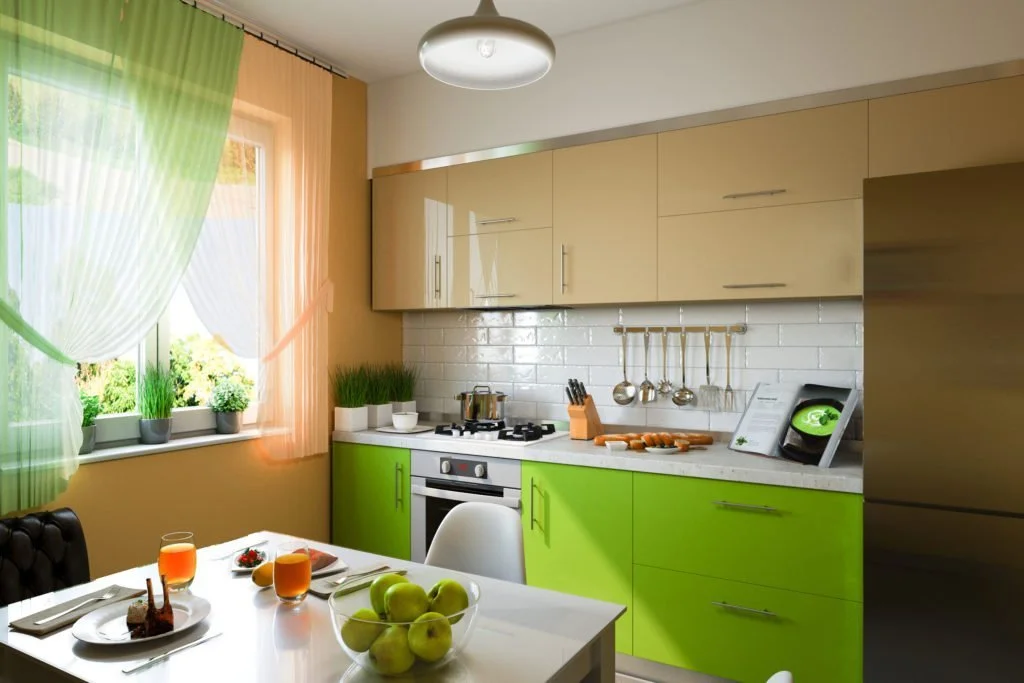
The Importance of Color in Your Dream Kitchen Design
A warm and welcoming kitchen is the heart and soul of a happy home. However, this importance means that you need to take extra care when redecorating or remodeling in Denver. Even something as minor as a new coat of paint can mean days of upheaval, and major work is something you’ll want to undertake judiciously.
Therefore, it’s vital to get things right from the planning stage onward; this goes for your color choice as much as any layout or furnishing decisions. What should you consider when deciding on a color scheme for a kitchen you’ll love to spend time in?

Simplicity is Everything
The average kitchen is an extremely busy room, not just in activity, but in its contents as well. No matter how neat and tidy you keep it, there will always be some degree of clutter as shelves fill up with ingredient packets and work surfaces become home to increasing numbers of gadgets and utensils. To minimize the risk of clutter, when choosing your basic color scheme, bear in mind that it should be kept fairly simple.
Major Features and Appliances
From original wooden beams to antique window frames, some parts of your kitchen can’t easily be changed without major expense. This means you need to plan around them from the beginning, making them a source of inspiration rather than a restriction. In the same way, unless you’re doing a complete remodel from the ground up, you probably already have a range of appliances which you need to fit into your decor. Take your non-negotiable items as a starting point for your design, rather than trying to shoehorn them in at the later stages.
Walls
Your first choice of color for the walls should be a light, neutral shade, acting as a canvas on which to paint the rest of your design. One major aspect to consider is the effect of lighting conditions on your chosen color. If you have a large window giving floods of natural light, then pale pastel shades can be warm and relaxing. However, under artificial light, they can be harsh and clinical. Try testing a range of color combinations under different lighting types, using swatches and color charts, before settling on a choice.
Although wall colors should be simple, they don’t need to be monochromatic. Remember the 60-30-10 rule when choosing a color scheme: your main color should take up roughly 60 percent of the available space, with a complementary shade covering 30 percent, and the last 10 percent reserved for eye-catching highlights or flourishes.
Floors
You can afford to go slightly darker in your choice of floor color, as the contrast with lighter walls will help make the space feel roomier rather than claustrophobic. As another plus point, floors in darker hues are better at hiding dirt and spills, and materials such as dark stone or hardwood are not difficult to clean.
It may be helpful to break up larger expanses of dark flooring, perhaps with a rug or two, just to stop it from becoming too dominating. Be wary of introducing complicated patterns to your floor, however, as these will tend to draw the eye downward and detract from any sense of spaciousness.
Cabinets
If your kitchen plan features a large number of cabinets, then it makes sense to choose lighter shades to create a bright and breezy feel. However, this doesn’t mean you need to stick to clinical white or dreary beige. Why not choose a light cherry stain, which would be particularly effective on inset panels? Combine this with splashes of brighter color for the handles and doorknobs. The effect can be pretty without becoming garish.
Work Surfaces
Your work surfaces are another area in which a darker shade can be both attractive and practical. Darkly stained wood or granite will be forgiving of light messiness, while providing contrast with paler walls or cabinets. The effect can be especially worthwhile if the work surfaces’ color is somewhere between a dark floor and the lighter shades of walls and cabinets.
Finishing Touches
Designing a relatively neutral basis to build on lets you give your imagination free rein with additional furniture, ornament collections, or shelving contents. For example, stools around a breakfast bar look great in a jaunty shade, while display cabinets can offer an ever-changing variety of crockery or decorative jars in eye-catching colors. These finishing touches can truly set the tone, and when you want some variety, they are easily changeable.
More than almost any other room, your kitchen decor needs to hit the mark the first time around, as you’ll be reluctant to change it too often. An essential part of this is your choice of colors, which can make all the difference between creating a purely functional space or the focal point of contented domestic life. Striking Remodels by Bell has the expertise and design eye to help you design your dream kitchen. Your remodel just got that much easier with Bell.
The Author:
Bell Plumbing & Heating has been providing customers with plumbing and heating services since 1926, but that?s not all we do today. We also offer kitchen and bathroom remodeling services (we?ve been remodeling kitchens and bathrooms for over 50 years now), drain and sewer line services, and electrical repairs and installations. Visit us at https://strikingremodels.com/
